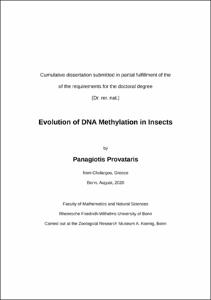Provataris, Panagiotis: Evolution of DNA methylation in insects. - Bonn, 2021. - Dissertation, Rheinische Friedrich-Wilhelms-Universität Bonn.
Online-Ausgabe in bonndoc: https://nbn-resolving.org/urn:nbn:de:hbz:5-62061
Online-Ausgabe in bonndoc: https://nbn-resolving.org/urn:nbn:de:hbz:5-62061
@phdthesis{handle:20.500.11811/9097,
urn: https://nbn-resolving.org/urn:nbn:de:hbz:5-62061,
author = {{Panagiotis Provataris}},
title = {Evolution of DNA methylation in insects},
school = {Rheinische Friedrich-Wilhelms-Universität Bonn},
year = 2021,
month = may,
note = {DNA methylation, the addition of a methyl group (-CH3) to a genomic cytosine by a DNA methyltransferase, is the most thoroughly studied epigenetic modification across eukaryotes. Functionally, it is associated with the regulation of gene expression and the silencing of transposable elements. Most of our knowledge about DNA methylation comes from model organisms that taxonomically belong to vertebrate animals and plants. In invertebrate animals, the most well-studied group is insects. Studied insects possess sparsely methylated genomes in comparison to vertebrate and other invertebrate animals, an observation that has led to the assumption that DNA methylation has been ancestrally reduced in insects. However, DNA methylation has only been studied in a taxonomically restricted group of insect species. Here I present a comprehensive comparative study of DNA methylation that covers all major extant insect groups. By performing computational and experimental comparative analyses I discovered that DNA methylation was reduced in the last common ancestor of holometabolous insects, while hemimetabolous insects show similar patterns of DNA methylation with other invertebrate animals. Additionally, I identified that DNA methyltransferase 1 is necessary and can be sufficient for the insect DNA methylation machinery to remain functional. By utilizing a novel approach for the classification of DNA methylation patterns in insects, I propose that transposable elements have played a major role in the evolutionary transitions among insect DNA methylation patterns. Furthermore, by creating a mechanistic model to explain the evolutionary trajectories of DNA methylation in insects, I recognized that DNA methylation has followed opposite evolutionary trajectories in insects and vertebrates that are shaped in both groups by the interplay between transposable elements and DNA methylation. I anticipate that this work will contribute towards understanding how the molecular biodiversity of insects, the most speciose group of animals, emerged.},
url = {https://hdl.handle.net/20.500.11811/9097}
}
urn: https://nbn-resolving.org/urn:nbn:de:hbz:5-62061,
author = {{Panagiotis Provataris}},
title = {Evolution of DNA methylation in insects},
school = {Rheinische Friedrich-Wilhelms-Universität Bonn},
year = 2021,
month = may,
note = {DNA methylation, the addition of a methyl group (-CH3) to a genomic cytosine by a DNA methyltransferase, is the most thoroughly studied epigenetic modification across eukaryotes. Functionally, it is associated with the regulation of gene expression and the silencing of transposable elements. Most of our knowledge about DNA methylation comes from model organisms that taxonomically belong to vertebrate animals and plants. In invertebrate animals, the most well-studied group is insects. Studied insects possess sparsely methylated genomes in comparison to vertebrate and other invertebrate animals, an observation that has led to the assumption that DNA methylation has been ancestrally reduced in insects. However, DNA methylation has only been studied in a taxonomically restricted group of insect species. Here I present a comprehensive comparative study of DNA methylation that covers all major extant insect groups. By performing computational and experimental comparative analyses I discovered that DNA methylation was reduced in the last common ancestor of holometabolous insects, while hemimetabolous insects show similar patterns of DNA methylation with other invertebrate animals. Additionally, I identified that DNA methyltransferase 1 is necessary and can be sufficient for the insect DNA methylation machinery to remain functional. By utilizing a novel approach for the classification of DNA methylation patterns in insects, I propose that transposable elements have played a major role in the evolutionary transitions among insect DNA methylation patterns. Furthermore, by creating a mechanistic model to explain the evolutionary trajectories of DNA methylation in insects, I recognized that DNA methylation has followed opposite evolutionary trajectories in insects and vertebrates that are shaped in both groups by the interplay between transposable elements and DNA methylation. I anticipate that this work will contribute towards understanding how the molecular biodiversity of insects, the most speciose group of animals, emerged.},
url = {https://hdl.handle.net/20.500.11811/9097}
}






